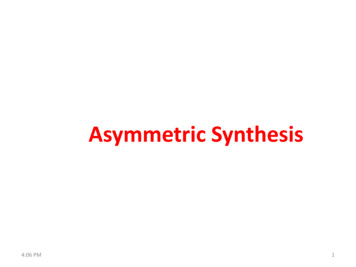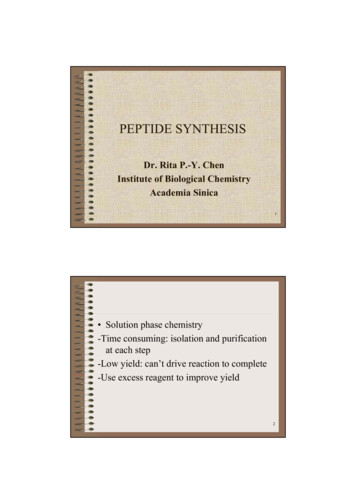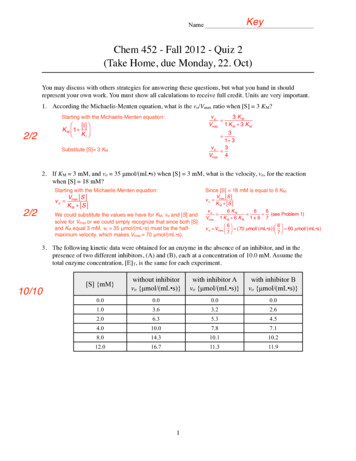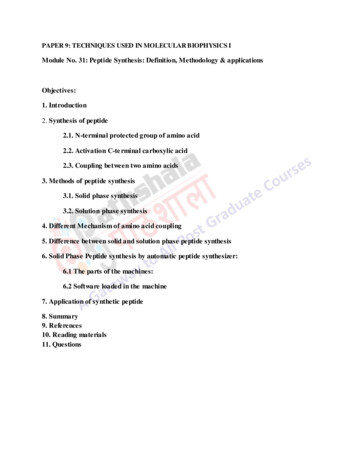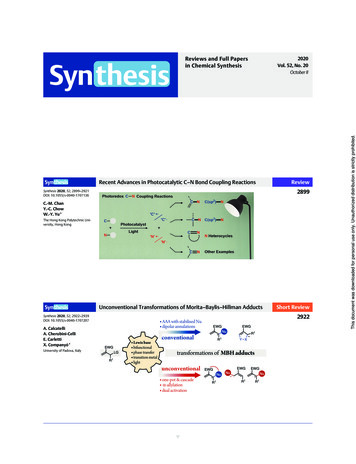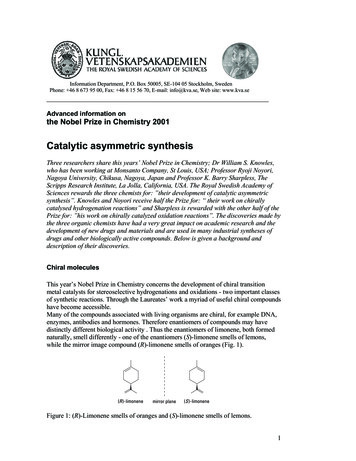
Transcription
Information Department, P.O. Box 50005, SE-104 05 Stockholm, SwedenPhone: 46 8 673 95 00, Fax: 46 8 15 56 70, E-mail: info@kva.se, Web site: www.kva.seAdvanced information onthe Nobel Prize in Chemistry 2001Catalytic asymmetric synthesisThree researchers share this years’ Nobel Prize in Chemistry; Dr William S. Knowles,who has been working at Monsanto Company, St Louis, USA; Professor Ryoji Noyori,Nagoya University, Chikusa, Nagoya, Japan and Professor K. Barry Sharpless, TheScripps Research Institute, La Jolla, California, USA. The Royal Swedish Academy ofSciences rewards the three chemists for: ”their development of catalytic asymmetricsynthesis”. Knowles and Noyori receive half the Prize for: “ their work on chirallycatalysed hydrogenation reactions” and Sharpless is rewarded with the other half of thePrize for: ”his work on chirally catalyzed oxidation reactions”. The discoveries made bythe three organic chemists have had a very great impact on academic research and thedevelopment of new drugs and materials and are used in many industrial syntheses ofdrugs and other biologically active compounds. Below is given a background anddescription of their discoveries.Chiral moleculesThis year’s Nobel Prize in Chemistry concerns the development of chiral transitionmetal catalysts for stereoselective hydrogenations and oxidations - two important classesof synthetic reactions. Through the Laureates’ work a myriad of useful chiral compoundshave become accessible.Many of the compounds associated with living organisms are chiral, for example DNA,enzymes, antibodies and hormones. Therefore enantiomers of compounds may havedistinctly different biological activity . Thus the enantiomers of limonene, both formednaturally, smell differently - one of the enantiomers (S)-limonene smells of lemons,while the mirror image compound (R)-limonene smells of oranges (Fig. 1).Figure 1: (R)-Limonene smells of oranges and (S)-limonene smells of lemons.1
We distinguish between these enantiomers because our nasal receptors are also made upof chiral molecules that recognise the difference. Insects use chiral chemical messengers(pheromones) as sex attractants and chemists have discovered that one of theenantiomers of the insect pheromone, olean, attracts male fruit flies, while its mirrorimage operates on the female of the species.Thus biology is very sensitive to chirality and the activity of drugs also depends onwhich enantiomer is used. Most drugs consist of chiral molecules. And since a drug mustmatch the receptor in the cell, it is often only one of the enantiomers that is of interest. Incertain cases the other enantiomer may be harmful. In the early 1960s, the drugthalidomide was prescribed to alleviate morning sickness in pregnant woman.Tragically, the drug also caused deformities in the limbs of children born by thesewomen. It seems that one enantiomer of thalidomide was beneficial while the othercaused the birth defects. This theory is being questioned, partly because the twoenantiomers of thalidomide easily can interconvert in the body. Pharmaceuticalcompanies nowadays have to make sure that both enantiomers of a drug are tested fortheir biological activity and toxicity before they are marketed. Obviously, there is astrong demand for to the pure enantiomers.Catalytic asymmetric synthesesIndustrial companies are concerned about disposing of unwanted compounds and alsoabout the inefficiency and costs involved in the chemical processes. Therefore there is astrong demand for efficient methods for asymmetric syntheses. Thus finding newmethods of asymmetric synthesis has in the past 20 or 30 years become a key activity fororganic chemists. Ideally, a chiral agent should behave as a catalyst with enzyme-likeselectivity. A small amount of material containing the chiral information could generatea large amount of a chiral product. Research has been intensive to develop methods forcatalytic asymmetric synthesis i.e. catalytic methods to prepare one of the enantiomers inpreference to the other. In a catalytic asymmetric reaction, a chiral catalyst is used toproduce large quantities of an optically active compound from a precursor that may bechiral or achiral. In recent years, synthetic chemists have developed numerous catalyticasymmetric syntheses that convert prochiral substrates into chiral products with highenantioselectivity. These developments have had an enormous impact on academic andindustral organic syntheses. One single chiral catalyst molecule can direct thestereoselection of millions of chiral product molecules. Such reactions are thus highlyproductive and economical, and, when applicable, they make the waste resulting fromracemate resolution obsolete.It is researchers in this field who are rewarded with this year’s Nobel Prize in Chemistry.2
Knowles pioneer workIn the early sixties it was not known whether catalytic asymmetric hydrogenation wasfeasible. A breakthrough came in 1968 when Knowles at Monsanto Company, St. Louisshowed that a chiral transition metal based catalyst could transfer chirality to a nonchiral substrate resulting in chiral product with one of the enantiomers in excess.1Two developments in the mid-sixties offered an attractive approach to making such acatalyst. The first was the discovery by Osborn and Wilkinson of the rhodium complex,[(PPh3)3RhCl], as a soluble hydrogenation catalyst for unhindered olefins. Homogeneouscatalysts had been reported earlier, but this was the first one that compared in rates withthe well-known heterogeneous counterparts.2The other development was the discovery of methods for preparing optically activephosphines by Horner3 and by Mislow4. Knowles’ basic strategy was to replacetriphenylphosphine in Osborn and Wilkinson’s catalyst with the enantiomer of a knownchiral phosphine and hydrogenate a prochiral olefine.Knowles soon verified the validity of this thinking by using the known non-racemicmethylpropylphenylphosphine (69% of ee of (-)-methylpropylphenylphosphine) andreducing substituted styrenes (Fig. 2).Figure 2: Knowles’s catalytic asymmetric hydrogenation of α-phenylacrylic acid using arhodium catalyst containing (-)-methylpropylphenylphosphine (69% ee) gave ( )hydratropic acid in 15% ee.A modest enantiomeric excess (ee) was obtained but it was too small to be of anypractictical use. However, the result proved that it was in fact possible to achievecatalytic asymmetric hydrogenation. Other researchers (Horner5, Kagan6, Morrison7 andBosnich) reached similar results shortly afterwards and they have all contributed toopening the doors to a new, exciting and important field for both academic and industrialresearch.3
The first industrial catalytic asymmetric synthesisThe problem was now to find a proper match between ligand and substrate to achievesynthetically useful efficiencies. As it turned out, good results were obtained only withmore functionalized substrates. The best substrate was an enamide precursor of α-aminoacids. Knowles’s aim was to develop an industrial synthesis of the rare amino acid LDOPA which had proved useful in the treatment of Parkinson’s disease. Knowles andco-workers at Monsanto discovered that a cationic rhodium complex containingDiPAMP , a chelating diphosphine with two chiral phophorus atoms, catalyzes highlyenantioselective hydrogenations of enamides such as A (Fig. 3). In the key step of thesyntheses of L-DOPA enamide A is hydrogenated in the presence of a catalytic amountof [Rh(R,R)-DiPAMP)COD] BF4 affording the protected amino acid B in quantitativeyield and in 95% ee. A simple acid-catalyzed hydrolysis step completes the syntheses ofL-DOPA8.Figure 3: The Monsanto synthesis of L-DOPA using catalytic asymmetrichydrogenation.The Monsanto Process was the first commercialized catalytic asymmetric synthesisemploying a chiral transition metal complex and it has been in operation since 1974. Thespectacular success of this L-DOPA synthesis has significantly contributed to theexplosive growth of research aimed at the development and application of other catalyticasymmetric reactions in ensuing years.4
Mechanism of catalytic asymmetric hydrogenationThe reaction mechanism of the phosphine Rh complex-catalyzed hydrogenation hasbeen elucidated by Halpern9 and the mechanism of hydrogenation of an enamide using adiphosphine yielding a phenylalanine derivative is shown in Figure 4.Figure 4: Mechanism of Rh-diphosphine-catalyzed hydrogenation of an enamide.First, solvent molecules, S, in the catalyst precursor are displaced by the olefinicsubstrate to form a chelate-Rh complex in which the olefinic bond and the carbonyloxygen interact with the Rh(I) center. Hydrogen is oxidatively added to the metal toform a Rh(III) dihydride intermediate. The two hydrogen atoms on the metal aresuccessively transferred to the carbons of the coordinated olefinic bond by way of a fivemembered chelate alkyl-Rh(III) intermediate. The secondary binding of the carbonyloxygen of the amide moiety results in a ring system that stabilizes the reactiveintermediate. Kinetic data suggest that, at room temperature, the oxidative addition of H2is rate limiting for the overall reaction. When an appropriate chiral phosphine ligand andproper reaction conditions are chosen, high enantioselectivity is achieved. If adiphosphine ligand of C2 symmetry is used, two diastereoisomers of the enamidecoordination complex can be produced, because the olefin interacts with either the reface or the si face. This interaction leads to enantiomeric phenylalanine products viadiastereoisomeric Rh(III) complexes.In order to develop improved asymmetric catalysts the energy difference between thediasteroisomeric activated complexes has to be increased to yield larger ee. This isimportant for industrial applications. The leader of this development is another of thisyear’s Laureates in Chemistry, Ryoji Noyori.5
Noyori’s general hydrogenation catalystsAn early example of molecular asymmetric catalysis using homogeneous transitionmetal complexes - enantioselective cyclopropanation of olefins - was reported in 1966by Noyori, together with H. Nozaki. However, the stereoselectivity was low.In 1980, Noyori, together with Takaya, discovered an atropisomeric chiral diphosphine,BINAP. Rh(I) complexes of the enantiomers of BINAP are remarkably effective invarious kinds ofFigure 5: The two enantiomers of the versatile diphosphine ligand BINAP is shown.asymmetric catalysis.10 This includes enantioselective hydrogenation of α(acylamino)acrylic acids or esters, giving amino acid derivatives and also includesenantioselective isomerization of allylic amines to enamines. The chiral efficiency ofBINAP chemistry originates from unique dissymmetric templates created by a transitionmetal atom or ions and the C2 chiral diphosphine.Noyori’s discovery of the BINAP-Ru(II) complex catalysts was a major advance instereoselective organic synthesis. The scope of the application of these catalysts is farreaching. These chiral Ru complexes serve as catalyst precursors for the highlyenantioselective hydrogenation of a range of α,β- and β,γ-unsaturated carboxylic acids.11An example is shown in Figure 6.Figure 6: The anti-inflammatory agent (S)-naproxen is produced in high yield and highenantiomeric excess using Noyori’s catalyst.6
This reaction, unlike Rh(I)-catalyzed olefin hydrogenation, proceeds via a metalmonohydride mechanism.The enantioselectivity is much higher than when utilizing theRh catalyst and the sense of asymmetric induction is the opposite.In the presence of the halogen-containing complexes [RuX(arene)(binap)]X orRuX2(binap) (X Cl, Br, I) a wide range of functionalized ketones can be hydrogenatedin a highly enantioselective and predictable manner. Various functionalities can act asdirecting groups.12Figure 7: The (R)-BINAP-Ru-(II)-catalyzed hydrogenation of acetol to (R)-1,2propanediol is currently used for the industrial synthesis of antibacterial levofloxacin.The hydrogenation method is effective for converting β-keto carboxylic esters into βhydroxy esters in high (up to 100%) enatiomeric purity. This entirely chemical approachis far superior to any biological versions, including bakers yeast reduction, whereefficiency is often variable.Thus Noyori s newly invented BINAP-Ru(II) complexes exhibit an extremely highchiral recognition ability in the hydrogenation of a variety of functionalized olefins andketones. Both product enantiomers can be synthesized efficiently and with equal ease bychoosing the proper enantiomers of the catalysts. This transition metal catalysis is clean,simple and economical to operate and hence is capable of conducting a reaction on anyscale from 100 mg to 100 kg with a very high (up to 50%) substrate concentration inorganic solvents. In addition to industrial production of compounds such as (R)-1,2propanediol (10 tons/year) and a chiral azetidinone for carbapenem synthesis (120tons/year), this hydrogenation method is utilized in academic and industrial researchlaboratories to develop pharmaceuticals, agrochemicals, flavours and fragrances.Most existing homogeneous and heterogeneous catalyses using molecular hydrogensaturate carbon-carbon multiple bonds preferentially over a carbonyl moiety. ThusRuCl2[P(C6H5)3]3 normally shows feeble catalytic activity in the hydrogenation ofsimple ketones such as acetophenone. However, Noyori recently reported a remarkableenhancement in the reactivity of the Ru(II) catalyst by the addition of ethylene diamineand KOH in 2-propanol. The addition of very small amounts of these basic agentsentirely reverses the chemoselectivity from olefin-selective to carbonyl-selective.13Efficient asymmetric hydrogenation of α,β-unsaturated ketones has been an enduringproblem in organic chemistry. In the example in Figure 8 the combined use of chiral7
RuCl2(xylylbinap)(diamine) and the weak base K2CO3 transforms a simple enone byenantioselective hydrogenation into a chiral allylic alcohol. The substrate/catalyst ratioapproaches 100 000. This chemoselectivity is remarkable in view of the large catalyticactivity of diamine-free BINAP-Ru complexes for hydrogenation of CC double bonds inallylic alcohols.Figure 8: A simple enone is transformed by enantioselective hydrogenation into a chiralallylic alcohol using a novel Noyori catalyst.Apart from asymmetric catalysis, this carbonyl-selective hydrogenation provides a realadvance in organic synthesis. A wide range of ketones and aldehydes possessing carboncarbon multiple bonds are hydrogenated preferentially at the carbonyl group, leading tounsaturated alcohols. Both conjugated and unconjugated enones and enals may be used.Sharpless’s chirally catalyzed oxidationsParallell to the progress in catalytic asymmetric hydrogenations Barry Sharpless hasdeveloped chiral catalysts for very important oxidation reactions. The epoxidationreaction discovered in 1980 by Sharpless and Kazuki is a very fine example of a strategyof using a reagent to achieve stereochemical control. Using titanium(IV)tetraisopropoxide, tert-butyl hydroperoxide, and an enantiomerically pure dialkyltartrate, the Sharpless reaction accomplishes the epoxidation of allylic alcohols withexcellent stereoselectivity. This powerful reaction is very predictable.When the D-(-)-tartrate ligand (D-(-)-DET) is used in epoxidation, the oxygen atom isdelivered to the top face of the olefin when the allylic alcohol is depicted as in Figure 9(i.e. OH group in lower right hand corner).8
Figure 9: The predictive stereoselectivity of the Sharpless epoxidation is shown togetherwith an example of its regioselectivity.The L-( )-tartrate ligand (L-( )-DET), on the other hand, allows the bottom face of theolefin to be epoxidised. When achiral allylic alcohols are employed, the Sharplessreaction exhibits exceptional enantiofacial selectivity (ca. 100:1) and providesconvenient access to synthetically versatile epoxy alcohols.The emergence of the powerful Sharpless asymmetric epoxidation in the 1980s hasstimulated major advances in both academic and industrial organic synthesis. Throughthe action of an enantiomerically pure titanium-tartrate complex, a myriad of achiral andchiral allylic alcohols can be epoxidised with exceptional stereoselectivity. Interest in theSharpless epoxidation as a tool for industrial organic synthesis increased substantiallyafter Sharpless et al. had discovered that the asymmetric epoxidation process can beconducted with catalytic amounts of the enantiomerically pure titanium-tartrate complexsimply by adding molecular sieves to the epoxidation reaction mixture.14 Using thispractical and reproducible catalytic variant, an industrial process for ton-scaleproductions of (S)- and (R)-glycidol and (S)- and (R)-methylglycidol has beendeveloped. These low molecular weight epoxy alcohols are versatile building blocks forthe synthesis of a number of chiral molecules. As an example glycidol is used in thepharmaceutical industry to produce β-blockers, used as heart medicines.Another successful industrial application of the Sharpless epoxidation, is the synthesis of(7R,8S)-disparlure, the pheromone of the gypsy moth.The cis dihydroxylation of olefins first reported early last century is another most usefuloxidation reaction. It converts an olefin to a vicinal diol present in many natural productsand unnatural molecules. The original dihydroxylation reaction used stoichiometric9
amounts of osmium tetroxide (OsO4), which is expensive, volatile and toxic, with theresult that even small-scale reactions were inconvenient. However, the dihydroxylationshows specificity for double bonds and has no particular substrate requirements, whichwere advantages. Over the years, the original dihydroxylation procedure has beenmodified to operate catalytically, more rapidly, and in better yield.Methods for the conversion of olefins to diols with only catalytic amounts of osmiumtetroxide and a stoichiometric co-oxidant have been known almost as long as thereaction itself. Criegee first observed that the addition of amines, such as pyridine, to thedihydroxylation reaction increases its rate. Presumably this is due to the formation of anelectron-rich coordination complex with the osmium atom. A useful stoichiometric cooxidant is N-methylmorpholine N-oxide (NMO).The first attempt at non-enzymatic asymmetric dihydroxylation utilized a chiral,enantiomerically pure pyridine to determine if this induced asymmetry in the diol. Amodest ee was obtained. However, the cinchona alkaloid ligands proved to have morebalanced properties and gave more pronounced ”ligand accelerated catalysis”. Thisconcept was introduced by Sharpless in the same paper where he reported the firstcatalytic asymmetric dihydroxylation. The seemingly trivial marriage of the Sharplesscinchona alkaloid stoichiometric dihydroxylation process (now optimized with theligand in Figure 10) with the practical qualities of NMO resulted in good yields andmoderate to good enatiomeric excesses.15 An example is shown in Figure 10.Figure 10: Catalytic asymmetric dihydroxylation developed by Sharpless.Since Sharpless’s discovery of the chirally catalyzed dihydroxylations, there has beenconsiderable progress with respect to the understanding of the reaction mechanism.Better ligands have been designed and procedures have been improved makingSharpless’s catalytic asymmetric dihydroxylation an extremely useful reaction.10
Consequences and applicationsSome of the applications of the Laureates’ pioneering work have already been discussed.It is especially important to emphasise the great significance their discoveries andimprovements have for industry. Industrial syntheses of new drugs are of majorimportance, but we may also mention the production of agro-chemicals includingpheromones, flavours, fragrances and sweetening agents. This year’s Nobel Prize inChemistry shows that the step from basic research to industrial application cansometimes be a short one.All around the world many research groups are busy developing other catalyticasymmetric syntheses that have been inspired by the Laureates’ discoveries. Theirdevelopments have provided academic research with many important tools, therebycontributing to more rapid advances of research - not only in chemistry but also inmaterials science, biology and medicine. Their work gives access to new moleculesneeded to investigate hitherto unexplained and undiscovered phenomena in themolecular world.Per Ahlberg,Professor of Organic Chemistry, Göteborg University,member of the Nobel Committee for ChemistryReferences[1]W.S. Knowles and M.J. Sabacky, Chem. Commun., 1445 (1968).[2]J.A. Osborn, F.H. Jardine, J.F. Young, and G. Wilkinson, J. Chem. Soc. A, 1711(1966).[3]L. Horner, H. Winkler, A. Rapp, A. Mentrup, H. Hoffman and P. Beck,Tetrahedron Letters, 161 (1961).[4]O. Korpiun and K. Mislow, J. Am. Chem. Soc., 89, 4784 (1967).[5]L. Horner, H. Siegel, and H. Büthe, Angew. Chem., 80, 1034 (1968); Angew.Chem., Int. Ed. Engl., 7, 942 (1968). (b) L. Horner, H. Büthe and H. Siegel,Tetrahedron Letters, 37, 4023, (1968).[6]T.P. Dang and H.B. Kagan, Chem. Commun., 481 (1971).[7]J.D. Morrison, R.E. Burnett, A.M. Aguiar, C.J. Morrow and C. Phillips, J. Am.Chem. Soc., 93, 1301 (1971).[8]W.S. Knowles, Acc. Chem. Res. 16, 106 (1983).[9]J. Halpern, “Asymmetric Catalytic Hydrogenation: Mechanism and Origin ofEnatioselection”, in J.D. Morrison, ed., Asymmetric Synthesis, Vol. 5, Chap. 2,Academic Press, New York, 1985.11
[10]A. Miyashita, A. Yasuda, H. Takaya, K. Toriumi, T. Ito, T. Souchi and R.Noyori, J.Am.Chem. Soc. 102, 7932 (1980).[11]T. Ohta, H. Takaya and R. Noyori, Inorg. Chem., 27, 566 (1988).[12]M. Kitamura, T. Ohkuma, S. Inoue, N. Sayo, H. Kumobayashi, S. Akutagawa, T.Otha, H. Takaya and R. Noyori, J. Am, Chem. Soc., 110, 629 (1988).[13]T. Ohkuma, H. Ooka, S. Hashiguchi, T. Ikariya and R. Noyori, J. Am. Chem.Soc., 117, 2675 (1995).[14]T. Katsuki and K.B. Sharpless, J. Am. Chem. Soc. 102, 5974 (1980).[15]E.N. Jacobsen, I. Marko, W.S. Mungall, G. Schröder, K.B. Sharpless, J. Am.Chem. Soc., 110, 1968 (1988).Further readingClassics in Total Synthesis, K.C. Nicolaou and E.J. Sorensen, VCH, Weinheim, 1966.Asymmetric Catalysis in Organic Synthesis, R. Noyori, John Wiley and Sons, Inc., NY,1994Stereochemistry of Organic Compounds, E.L. Eliel and S.H. Wilen, John Wiley andSons, Inc., NY, 1994.12
strong demand for efficient methods for asymmetric syntheses. Thus finding new methods of asymmetric synthesis has in the past 20 or 30 years become a key activity for organic chemists. Ideally, a chiral agent should behave as a catalyst with enzyme-like selectivity. A small amount of material containing the chiral information could generate
